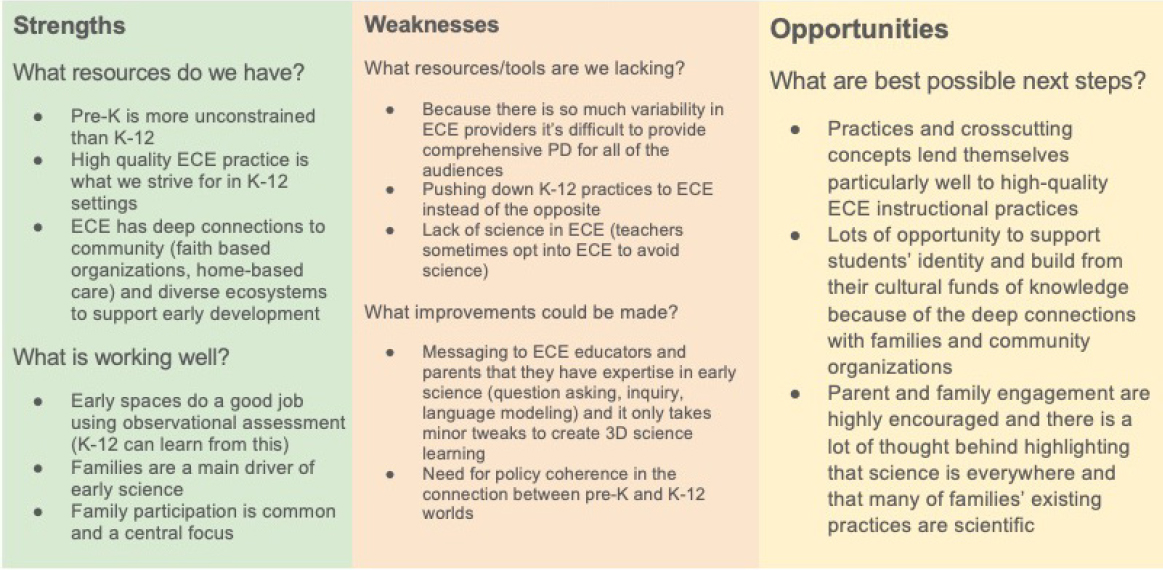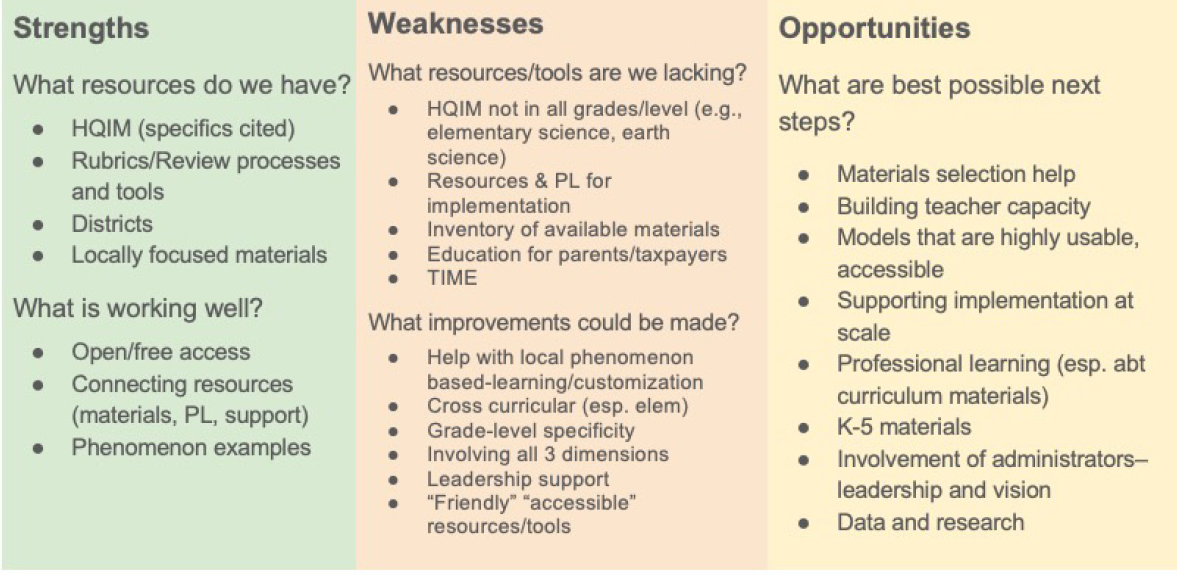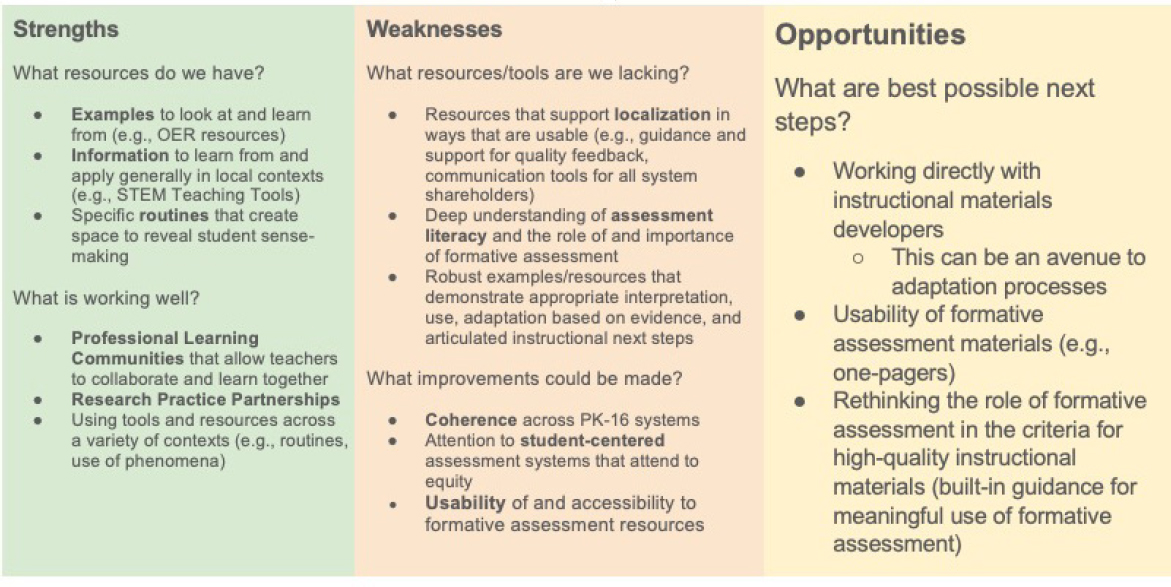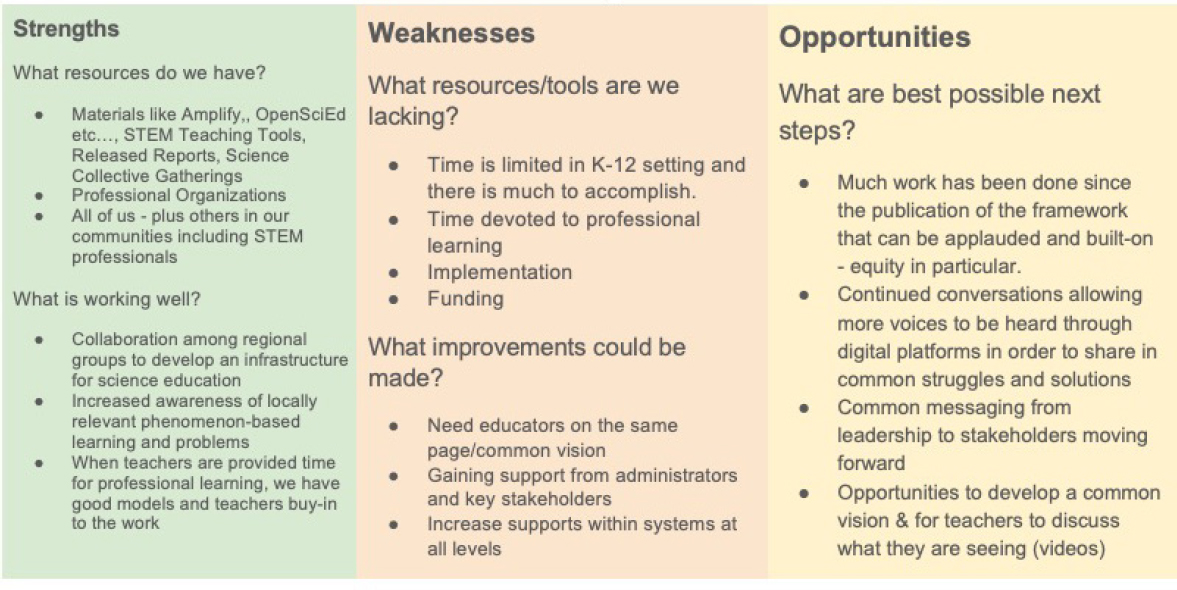9
Tools and Resources to Build Capacity and Drive Coherence
In this session, workshop participants divided into four breakout groups to discuss tools and resources geared toward building capacity and driving coherence for standards implementation. In these sessions, participants were asked to discuss the strengths, weaknesses, and opportunities in these areas. After the breakout groups concluded, workshop participants reconvened and provided brief synopses of their conversations, which were followed by a question-and-answer session. The four breakout groups were as follows:
- Preschool to Elementary Transition
- Curriculum and Instructional Materials
- Formative Assessment
- Instructional Practice
PRESCHOOL TO ELEMENTARY TRANSITION
One of the top strengths of the early childhood education (ECE) space is that it is more unconstrained than the K–12 setting, said Andres Bustamante (University of California, Irvine) (see Figure 9-1). Many K–12 educators report feeling beholden to a certain curriculum and worrying about high-stakes testing, whereas in the ECE space there is more opportunity to create exploration and hands-on playful learning. Many ECE teachers are already engaged in high-quality practices, such as open-ended questions and inquiry cycles, that are ideal for three-dimensional (3-D) science learning, he said. ECE providers also tend to use observational assessments to

NOTE: PD = professional development.
examine the quality of their practices, organization, and environment. K–12 could benefit from incorporating similar holistic assessment approaches that use some of these observational protocols, said Bustamante.
Another strength of ECE is its deep connections to community, such as faith-based organizations and home-based care. Even in publicly funded ECE, there is a focus on family engagement and building connections between home and school. Furthermore, said Bustamante, there is a diverse ecosystem of ECE providers, which allows children to see themselves and their culture in learning environments. This is something that “we really strive for” in K–12, he said.
One challenge in the ECE space, however, is the huge amount of variability in ECE providers, including state-funded pre–Ks, Head Start, faith-based groups, private businesses, and families. The education and training of individual providers varies widely, and there are a wide variety of settings and environments. Bustamante said that this makes it difficult to provide high-level supports or professional development opportunities for ECE providers. Another challenge, he said, is the unfortunate trend of K–12 practices being pushed down to ECE rather than the other way around. He explained that some ECE spaces, particularly those that serve children in underresourced neighborhoods and/or Black and Brown children, can get “caught up in some of the same pitfalls” of focusing on rote learning and memorization. Bustamante emphasized the need for building on the strengths of what ECE does well rather than pushing it to look more like K–12 education.
To capitalize on the strengths and opportunities within ECE, Bustamante said there is a need to convey to parents and teachers that many of them are already “doing science”; some minor tweaks and support could help ECE educators make explicit connections between their existing practices and 3-D science education. There are many opportunities to build upon students’ cultural funds of knowledge due to the deep connections between ECE and families and communities, and the unconstrained nature of the ECE space means that providers can use a “science is everywhere” approach.
CURRICULUM AND INSTRUCTIONAL MATERIALS
As discussed earlier in the workshop, said Christine Cunningham (Pennsylvania State University), there are several high-quality instructional materials that exist, and the number is growing (see Figure 9-2). There are rubrics and review processes and tools available, districts are acting as resources for one another, and materials have been developed that are relevant to local communities and cultures. Some materials are free and open access, and there are efforts to connect resources and professional learning opportunities across communities.

NOTE: HQIM = High-quality instructional materials; PL = professional learning.
The weaknesses in this area, said Cunningham, include a lack of tools and resources in certain areas. For example, elementary schools are sorely in need of additional resources, and there is a lack of materials for topics such as earth science. To fully implement the vision of the Framework and the NGSS, she said, there is a need for additional resources and professional learning opportunities; furthermore, teachers need dedicated time for learning, teaching, and planning. The breakout group had two innovative ideas to address weaknesses in this area. The first was to develop an inventory of what materials and resources are already developed to reduce duplicative efforts and increase collaboration and sharing. The second idea, said Cunningham, was to educate parents, taxpayers, and policy makers around the importance of the NGSS and the need for funds and time to implement the vision. Other needs that were identified by the breakout group included support for developing local phenomenon-based learning, cross-curricular materials, grade-level specific materials, and materials that are “friendly and accessible” to both educators and students. A workshop participant added that while the development of specific types of material is essential, it is critical to remember that material is part of a larger system that is coherent and aligned.
The group identified several immediate needs in the area of instructional materials including the following:
- Help with selecting materials
- Efforts to build teacher capacity
- Models that are highly usable and accessible
- Support for implementation at scale
- Professional learning about curriculum materials
- Materials for K–5 classrooms
- Involvement and buy-in from leadership and administrators
- Further data and research to help guide decision making
FORMATIVE ASSESSMENT
In the area of formative assessment, there are a number of examples to look at and information to learn from, said Sara Cooper (Independent Consultant) (see Figure 9-3). There are specific tools that teachers can implement in classrooms, such as routines that make space to reveal student sensemaking. Professional learning communities have been formed to allow teachers to collaborate and learn together, while research-practice partnerships are moving science forward in classrooms. Strategies that are used in classroom instruction are also being applied to professional learning opportunities for educators, administrators, and leaders.
However, despite this progress, said Cooper, there are notable weak-

NOTE: OER = open educational resources.
nesses. There is a lack of resources that support adaptation and localization of existing tools and resources; for example, there is a need for guidance and support for quality feedback, and communication tools for all system shareholders. There are areas of improvement around assessment literacy, particularly the role and importance of formative assessment in classrooms and the system as a whole. In addition, there is a need for more robust examples to demonstrate the appropriate use of formative assessment, how assessments can be adapted for local context, and articulated instructional next steps. Cooper said that improvements are needed in three specific areas: coherence across pre-K–16 systems, attention to student-centered assessment systems that attend to equity, and usability of and accessibility to formative assessment resources. Cooper noted that “boots-on-the-ground” teachers may not have access to materials or may not understand how best to use them; this may be particularly true for teachers who are isolated. One pressing need is to develop usable formative assessment materials such as one-pagers, to get these resources in the hands of educators. Other immediate needs include considering how to closely connect curriculum, instruction, and assessment, and working directly with instructional materials developers to build coherence across the system.
INSTRUCTIONAL PRACTICE
There are a great number of resources available for instructional practice, said Kate McNeill (Boston College), as well as professional organizations that are facilitating collaboration and sharing (see Figure 9-4). Teachers are becoming more aware of the need to use locally relevant phenomena in instruction, and when teachers are provided with the necessary time and opportunities for professional learning, “amazing work” is being done in classrooms. Time, however, remains a challenge, said McNeill. There is a lack of time dedicated to science instruction and planning in the K–12 setting; “if we want teachers to be doing this instructional shift, we need to give them time to engage in it.” In addition to time, a lack of funding is another challenge that constrains implementation of the NGSS.
The group identified several areas for improvement. There is a need to get all educators on the same page, with a common vision, and to build support from administrators and key stakeholders at all levels. There is a need to continue conversations with multiple voices and multiple perspectives to learn from one another, share resources, and learn how to adapt and adopt models and materials. Much work has been done since the publication of the Framework and the NGSS, said McNeill, and there are opportunities to continue to build on this success, particularly around equity. Importantly, we need to care and support teachers in their work. “Teaching has always

been hard, and it is particularly hard right now,” said McNeill, and teachers need time, support, and resources to do their important work.
There were three categories of needs that the group identified as urgent and important, said McNeill. First was systems and infrastructure: there is a need to elevate science to the forefront and develop a shared vision across schools, districts, states, and other stakeholders. Second was time: time provided for teachers and other stakeholders to engage in professional learning as a community to support these shifts. The third category was equity: equity needs to be at the center with a focus on what equitable science instruction looks like; for example, rather than focusing on scientific language, hearing and supporting the “brilliance that youth bring to the classroom.” As an example, McNeill shared a quote from a middle school science student who felt like part of the scientific endeavor and focused on the collaborative nature of inquiry: “We were the ones who came up with it, so we were able to understand. We had similar ideas or different ideas. So, we were able to come up with this one model that we could ALL understand because WE came up with it.”
This page intentionally left blank.










